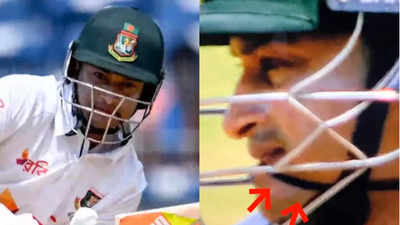
Shakib Al Hasan (Photo: Video grabs)
Former Bangladesh captain and veteran allrounder is using an interesting technique to get his stance and head position right while batting in the first Test against India at the MA Chidambaram Stadium in Chennai.
Images of a thin black band clenched between his teeth while facing up to a bowler have been doing the rounds on social media, leading to the question what makes Shakib do that.
Former India opener Aakash Chopra, who is also doing commentary in the two-match Test series, explained the reason when a batsman can attempt such unique corrective measures.
“While (the left-handed Shakib) is in his stance, he keeps pushing his head inwards, almost towards mid-on. Why he’s doing this is because somebody must have told him that he can do this to address the problem of his head falling over, which leads to the front foot going in the same direction (towards mid-off). If that happens, then your batting gets disturbed,” explained the 47-year-old Chopra, who played 10 Tests.
“So that thread or band he is holding in his teeth is at its peak tension when his head is inwards. He is trying to keep his head as close as possible to his right shoulder so that it doesn’t go to the other side, and it helps in keeping the front foot straighter,” said Chopra.
Images of a thin black band clenched between his teeth while facing up to a bowler have been doing the rounds on social media, leading to the question what makes Shakib do that.
Former India opener Aakash Chopra, who is also doing commentary in the two-match Test series, explained the reason when a batsman can attempt such unique corrective measures.
“While (the left-handed Shakib) is in his stance, he keeps pushing his head inwards, almost towards mid-on. Why he’s doing this is because somebody must have told him that he can do this to address the problem of his head falling over, which leads to the front foot going in the same direction (towards mid-off). If that happens, then your batting gets disturbed,” explained the 47-year-old Chopra, who played 10 Tests.
“So that thread or band he is holding in his teeth is at its peak tension when his head is inwards. He is trying to keep his head as close as possible to his right shoulder so that it doesn’t go to the other side, and it helps in keeping the front foot straighter,” said Chopra.
“One other thing he has added with this is changing his trigger movement, which normally happens with the feet (while playing a delivery).”
Chopra reckons Shakib has taken a leaf out of former India captain and coach Rahul Dravid’s book.
“Dravid (right-handed batsman) tried something similar (but not with any band), as he always tried to keep his head closer to his left shoulder. If your head is on your leading shoulder as a batsman, then your front foot movement is straighter. That’s what Shakib is doing.”

